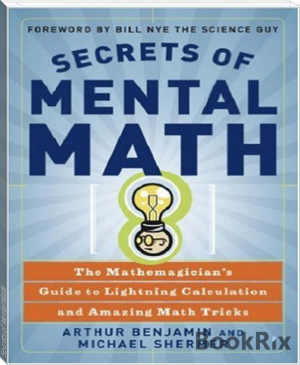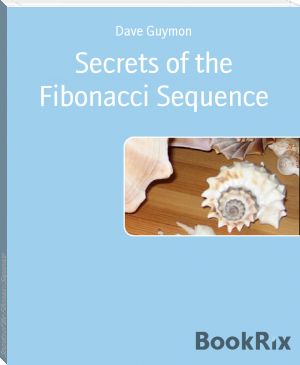Secrets of Mental Math by Arthur Benjamin (namjoon book recommendations TXT) 📖

- Author: Arthur Benjamin
Book online «Secrets of Mental Math by Arthur Benjamin (namjoon book recommendations TXT) 📖». Author Arthur Benjamin
There are relationships in Nature that numbers describe better than any other way we know. There are simple numbers that you can count on your hands: one, two, three, and on up. But there are also an infinite number of numbers in between. There are fractions. There are numbers that never end. They get as big as you want and so small that they’re hard to imagine. You can know them. With Secrets of Mental Math, you can have even these in-between numbers come so quickly to your mind that you’ll have a bit more space in your brain to think about why our world works this way. One way or another, this book will help you see that in Nature, it all adds up.
Foreword by James RandiForeword
by James Randi
Mathematics is a wonderful, elegant, and exceedingly useful language. It has its own vocabulary and syntax, its own verbs, nouns, and modifiers, and its own dialects and patois. It is used brilliantly by some, poorly by others. Some of us fear to pursue its more esoteric uses, while a few of us wield it like a sword to attack and conquer income tax forms or masses of data that resist the less courageous. This book does not guarantee to turn you into a Leibniz, or put you on stage as a Professor Algebra, but it will, I hope, bring you a new, exciting, and even entertaining view of what can be done with that wonderful invention—numbers.
We all think we know enough about arithmetic to get by, and we certainly feel no guilt about resorting to the handy pocket calculator that has become so much a part of our lives. But, just as photography may blind us to the beauty of a Vermeer painting, or an electronic keyboard may make us forget the magnificence of a Horowitz sonata, too much reliance on technology can deny us the pleasures that you will find in these pages.
I remember the delight I experienced as a child when I was shown that I could multiply by 25 merely by adding two 0s to my number and dividing by 4. Casting out 9s to check multiplication came next, and when I found out about cross-multiplying I was hooked and became, for a short while, a generally unbearable math nut. Immunizations against such afflictions are not available. You have to recover all by yourself. Beware!
This is a fun book. You wouldn’t have it in your hands right now if you didn’t have some interest either in improving your math skills or in satisfying a curiosity about this fascinating subject. As with all such instruction books, you may retain and use only a certain percentage of the varied tricks and methods described here, but that alone will make it worth the investment of your time.
I know both the authors rather well. Art Benjamin is not only one of those whiz kids we used to groan about in school but also has been known to tread the boards at the Magic Castle in Hollywood, performing demonstrations of his skill, and on one occasion he traveled to Tokyo, Japan, to pit his math skills against a lady savant on live television. Michael Shermer, with his specialized knowledge of science, has an excellent overview of practical applications of math as it is used in the real world.
If this is your first exposure to this kind of good math stuff, I envy you. You’ll discover, as you come upon each delicious new way to attack numbers, that you missed something in school. Mathematics, particularly arithmetic, is a powerful and dependable tool for day-to-day use that enables us to handle our complicated lives with more assurance and accuracy. Let Art and Michael show you how to round a few of the corners and cut through some of the traffic. Remember these words of Dr. Samuel Johnson, an eminently practical soul in all respects: “Arithemetical inquiries give entertainment in solitude by the practice, and reputation in public by the effect.”
Above all, enjoy the book. Let it entertain you, and have fun with it. That, with the occasional good deed, a slice of pizza (no anchovies!), and a selection of good friends is about all you can ask of life. Well, almost all. Maybe a Ferrari …
Prologue by Michael ShermerPrologue
by Michael Shermer
My good friend Dr. Arthur Benjamin, mathematics professor at Harvey Mudd College in Claremont, California, takes the stage to a round of applause at the Magic Castle, a celebrated magic club in Hollywood, where he is about to perform “mathemagics,” or what he calls the art of rapid mental calculation. Art appears nothing like a mathematics professor from a prestigious college. Astonishingly quick-witted, he looks at home with the rest of the young magicians playing at the Castle—which he is.
What makes Art so special is that he can play in front of any group, including professional mathematicians and magicians, because he can do something that almost no one else can. Art Benjamin can add, subtract, multiply, and divide numbers in his head faster than most people can with a calculator. He can square two-digit, three-digit, and four-digit numbers, as well as find square roots and cube roots, without writing anything down on paper. And he can teach you how to perform your own mathematical magic.
Traditionally, magicians refuse to disclose how they perform their tricks. If they did, everyone would know how they are done and the mystery and fascination of magic would be lost. But Art wants to get people excited about math. And he knows that one of the best ways to do so is to let you and other readers in on his secrets of “math genius.” With these skills, almost anyone can do what Art Benjamin does every time he gets on stage to perform his magic.
This particular night at the Magic Castle, Art begins by asking if anyone in the audience has a calculator. A group of engineers raise their hands and join Art on the stage. Offering to test their calculators to make sure they work, Art asks a member of the audience to call out a two-digit number. “Fifty-seven,” shouts one. Art points to another who yells out, “Twenty-three.”
Directing his attention to those on stage, Art tells them: “Multiply 57 by 23 on the calculator and make sure you get 1311 or the calculators are not working correctly.” Art waits patiently while the volunteers finish inputting the numbers. As each participant indicates his calculator reads 1311, the audience lets out a collective gasp. The amazing Art has beaten the calculators at their own game!
Art next informs the audience that he will square four two-digit numbers faster than his button-pushers on stage can square them on their calculators. The audience asks him to square the numbers 24, 38, 67, and 97. Then, in large, bold writing for everyone to see, Art writes: 576, 1444, 4489, 9409. Art turns to his engineer volunteers, each of whom is computing a two-digit square, and asks them to call out their answers. Their response triggers gasps and then applause from the audience: “576, 1444, 4489, 9409.” The woman next to me sits with her mouth open in amazement.
Art then offers to square three-digit numbers without even writing down the answer. “Five hundred and seventy-two,” a gentleman calls out. Art’s reply comes less than a second later: “572 squared is 327,184.” He immediately points to another member of the audience, who yells, “389,” followed by Art’s unblinking response: “389 squared will give you 151,321.” Someone else blurts out, “262.” “That’ll give you 68,644.” Sensing he delayed just an instant on that last one, he promises to make up for it on the next number. The challenge comes—991. With no pause, Art squares the number, “982,081.” Several more three-digit numbers are given and Art responds perfectly. Members of the audience shake their heads in disbelief.
With the audience in the palm of his hand, Art now declares that he will attempt to square a four-digit number. A woman calls out, “1,036,” and Art instantly responds, “That’s 1,073,296.” The audience laughs and Art explains, “No, no, that’s much too easy a number. I’m not supposed to beat the calculators on these. Let’s try another one.” A man offers a challenging 2,843. Pausing briefly between digits, Art responds: “Let’s see, the square of that should be 8 million … 82 thousand … 649.” He is right, of course, and the audience roars their approval, as loudly as they did for the previous magician who sawed a woman in half and made a dog disappear.
It is the same everywhere Art Benjamin goes, whether it is a high school auditorium, a college classroom, a professional conference, the Magic Castle, or a television studio. Professor Benjamin has performed his special brand of magic live all over the country and on numerous television talk shows. He has been the subject of investigation by a cognitive psychologist at Carnegie Mellon University and is featured in a scholarly book by Steven Smith called The Great Mental Calculators: The Psychology, Methods, and Lives of Calculating Prodigies, Past and Present. Art was born in Cleveland on March 19, 1961 (which he calculates was a Sunday, a skill he will teach you in Chapter 9). A hyperactive child, Art drove his teachers mad with his classroom antics, which included correcting the mathematical mistakes they occasionally made. Throughout this book when teaching you his mathematical secrets, Art recalls when and where he learned these skills, so I will save the fascinating stories for him to tell you.
Art Benjamin is an extraordinary individual with an extraordinary program to teach you rapid mental calculation. I offer these claims without hesitation, and ask only that you remember this does not come from a couple of guys promising miracles if you will only call




Comments (0)